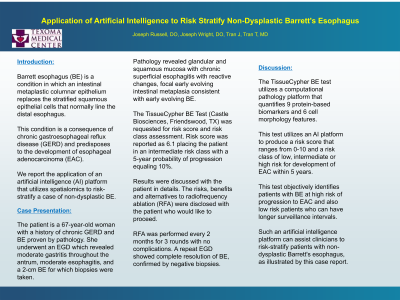Tuesday Poster Session
Category: Esophagus
P3968 - Application of Artificial Intelligence to Risk Stratify Non-Dysplastic Barrett's Esophagus
Tuesday, October 29, 2024
10:30 AM - 4:00 PM ET
Location: Exhibit Hall E

Has Audio
- JT
Jefferson Tran
TMC
Sherman, TX
Presenting Author(s)
Joseph Russell, DO1, Joseph Wright, DO1, Jefferson Tran, 2, Thomas Tran, MD1
1TMC, Denison, TX; 2TMC, Sherman, TX
Introduction: Barrett esophagus (BE) is a condition in which an intestinal metaplastic columnar epithelium replaces the stratified squamous epithelial cells that normally line the distal esophagus. This condition is a consequence of chronic gastroesophageal reflux disease (GERD) and predisposes to the development of esophageal adenocarcinoma (EAC). We report the application of an artificial intelligence (AI) platform that utilizes spatialomics to risk-stratify a case of non-dysplastic BE.
Case Description/Methods: The patient is a 67-year-old woman with a history of chronic GERD and BE proven by pathology. She underwent an EGD which revealed moderate gastritis throughout the antrum, moderate esophagitis, and a 2-cm BE for which biopsies were taken. Pathology revealed glandular and squamous mucosa with chronic superficial esophagitis with reactive changes, focal early evolving intestinal metaplasia consistent with early evolving BE. The TissueCypher BE Test (Castle Biosciences, Friendswood, TX) was requested for risk score and risk class assessment. Risk score was reported as 6.1 placing the patient in an intermediate risk class with a 5-year probability of progression equaling 10%. Results were discussed with the patient in details. The risks, benefits and alternatives to radiofrequency ablation (RFA) were disclosed with the patient who would like to proceed. RFA was performed every 2 months for 3 rounds with no complications. A repeat EGD showed complete resolution of BE, confirmed by negative biopsies.
Discussion: The TissueCypher BE test utilizes a computational pathology platform that quantifies 9 protein-based biomarkers and 6 cell morphology features using an AI platform to produce a risk score that ranges from 0-10 and a risk class of low, intermediate or high risk for development of EAC within 5 years. This test objectively identifies patients with BE at high risk of progression to EAC and also low risk patients who can have longer surveillance intervals. Such an artificial intelligence platform can assist clinicians to risk-stratify patients with non-dysplastic Barrett's esophagus, as illustrated by this case report.
Disclosures:
Joseph Russell, DO1, Joseph Wright, DO1, Jefferson Tran, 2, Thomas Tran, MD1. P3968 - Application of Artificial Intelligence to Risk Stratify Non-Dysplastic Barrett's Esophagus, ACG 2024 Annual Scientific Meeting Abstracts. Philadelphia, PA: American College of Gastroenterology.
1TMC, Denison, TX; 2TMC, Sherman, TX
Introduction: Barrett esophagus (BE) is a condition in which an intestinal metaplastic columnar epithelium replaces the stratified squamous epithelial cells that normally line the distal esophagus. This condition is a consequence of chronic gastroesophageal reflux disease (GERD) and predisposes to the development of esophageal adenocarcinoma (EAC). We report the application of an artificial intelligence (AI) platform that utilizes spatialomics to risk-stratify a case of non-dysplastic BE.
Case Description/Methods: The patient is a 67-year-old woman with a history of chronic GERD and BE proven by pathology. She underwent an EGD which revealed moderate gastritis throughout the antrum, moderate esophagitis, and a 2-cm BE for which biopsies were taken. Pathology revealed glandular and squamous mucosa with chronic superficial esophagitis with reactive changes, focal early evolving intestinal metaplasia consistent with early evolving BE. The TissueCypher BE Test (Castle Biosciences, Friendswood, TX) was requested for risk score and risk class assessment. Risk score was reported as 6.1 placing the patient in an intermediate risk class with a 5-year probability of progression equaling 10%. Results were discussed with the patient in details. The risks, benefits and alternatives to radiofrequency ablation (RFA) were disclosed with the patient who would like to proceed. RFA was performed every 2 months for 3 rounds with no complications. A repeat EGD showed complete resolution of BE, confirmed by negative biopsies.
Discussion: The TissueCypher BE test utilizes a computational pathology platform that quantifies 9 protein-based biomarkers and 6 cell morphology features using an AI platform to produce a risk score that ranges from 0-10 and a risk class of low, intermediate or high risk for development of EAC within 5 years. This test objectively identifies patients with BE at high risk of progression to EAC and also low risk patients who can have longer surveillance intervals. Such an artificial intelligence platform can assist clinicians to risk-stratify patients with non-dysplastic Barrett's esophagus, as illustrated by this case report.
Disclosures:
Joseph Russell indicated no relevant financial relationships.
Joseph Wright indicated no relevant financial relationships.
Jefferson Tran indicated no relevant financial relationships.
Thomas Tran indicated no relevant financial relationships.
Joseph Russell, DO1, Joseph Wright, DO1, Jefferson Tran, 2, Thomas Tran, MD1. P3968 - Application of Artificial Intelligence to Risk Stratify Non-Dysplastic Barrett's Esophagus, ACG 2024 Annual Scientific Meeting Abstracts. Philadelphia, PA: American College of Gastroenterology.
